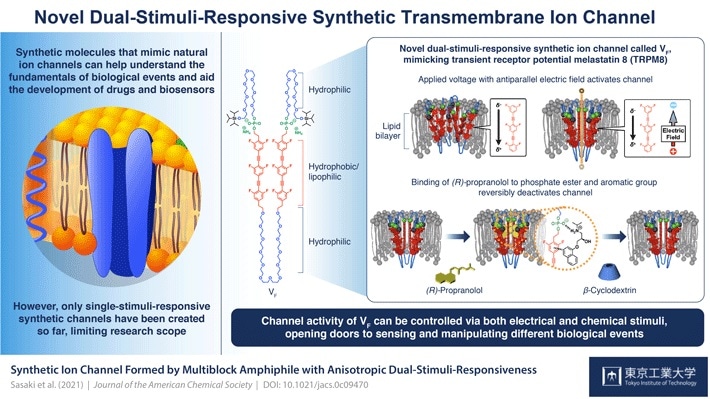For the first time, researchers from the Tokyo Institute of Technology (Tokyo Tech) and the University of Tokyo in Japan have produced a new artificial transmembrane ion channel—based on a naturally found transmembrane channel that plays a role in neuron signaling—that reacts to both electrical and chemical stimuli.

Image Credit: Tokyo Institute of Technology.
Considering its overall characteristics, the artificial channel paves the way to new possibilities in drug development, new fundamental studies on cellular transport and signaling, and the prospect for new kinds of biosensors.
The transmembrane ion channel is a crucial thread that holds together the fragile balance of a complex biological system These are multi-molecule, or supramolecular, routes of ion and molecule exchange integrated inside the cell membranes to assure crucial transport of chemicals to and from the cell and support cell signaling.
In the recent past, synthetic biomolecules that imitate the functions and structures of natural ion channels have attached a great deal of interest among molecular biology scientists as models for investigating the fundamentals of these ion channels and maybe, even developing sophisticated biosensors or producing drug alternatives.
However, while many good synthetic ion channels have been developed, the majority of these channels are stimulated through only one stimulus and none are what investigators call “anisotropic dual-stimuli-responsive, or ones that can be stimulated and regulated by two certain kinds of stimuli that rely on the biased orientation of the structure inside the membrane. This has restricted the scope of studies in the field.
Finally, a research team from Tokyo Tech and the University of Tokyo in Japan has effectively synthesized a biomolecule that looks like a natural anisotropic dual-stimuli-responsive channel—that is, transient receptor potential melastatin 8 (TRPM8), which is involved in signal transmissions in neurons. This newly synthesized channel is known as VF. The researchers’ finding has been published in Journal of the American Chemical Society.
VF is essentially a multiblock amphiphilic (that is, it has both fat-loving (lipophilic) and water-loving (hydrophilic) properties) molecule that can organize to form supramolecular channels.
Every unit in a block contains an organic hydrophobic/lipophilic moiety with six fluoride atoms that place it inside the lipid bilayer of the cell membrane and impart it an electrical polarity; a phosphate ester group which makes sure that the structure is biased in its direction (with the phosphate side toward the extracellular space); and also flexible ethylene glycol hydrophilic chains present between hydrophobic units and on the ends that play a role in the responsiveness of the stimuli.
Analyses of this structure demonstrated that when the polarities and amplitudes of applied voltages are manipulated, the channel could be stimulated.
Without the application of a voltage, the hydrophobic units of VF repel each other so that they would be spatially separated from each other and would not form clear and functional transmembrane ion channels.”
Kazushi Kinbara, Professor and Lead Scientist, Tokyo Institute of Technology
Professor Kinbara continued, “When a voltage with the electric field vector antiparallel to the electrical polarity of the VF is applied, a displacement of electron distribution within VF occurs, weakening the repulsion between hydrophobic units and enhancing their face-to-face stacking. This causes conformational changes throughout the molecule which leads to the formation of supramolecular channels that can efficiently transport ions across the membrane.”
The team observed that the second stimulus is associated with the binding of a ligand (R)-propranolol at the link between the hydrophobic units and the phosphate esters.
(R)-propranolol is an antiarrhythmic agent known to block voltage-gated sodium channels. Moreover, our previous studies indicated that it interacts with phosphate ester groups and aromatic units to localize inside the channel pore and block ion transport. That is why we chose it for our study.”
Kazushi Kinbara, Professor and Lead Scientist, Tokyo Institute of Technology
The researchers’ nuclear magnetic resonance spectroscopy demonstrated its binding at the sites of phosphate, and that it fully prevents the current flow and thereby the ion channel activity of VF. Its elimination through the addition of β-cyclodextrin again activates the ion channel.
Reversible ligand binding such as this is key to maintaining homeostasis within the body via the regulation of transmembrane ion channels. The highly regulated orientation of VF allowed for this anisotropic response to this ligand molecule. With our success in this study, there is now great potential for sensing and manipulating various biologically important events.”
Kazushi Kinbara, Professor and Lead Scientist, Tokyo Institute of Technology
Undoubtedly, with VF synthesis, which is appropriate for the variable cellular environments tha are ever-present in biological systems, new possibilities for research could emerge in the molecular biology field.
Source:
Journal reference:
Sasaki, R., et al. (2021) Synthetic Ion Channel Formed by Multiblock Amphiphile with Anisotropic Dual-Stimuli-Responsiveness. Journal of American Chemical Society. doi.org/10.1021/jacs.0c09470.